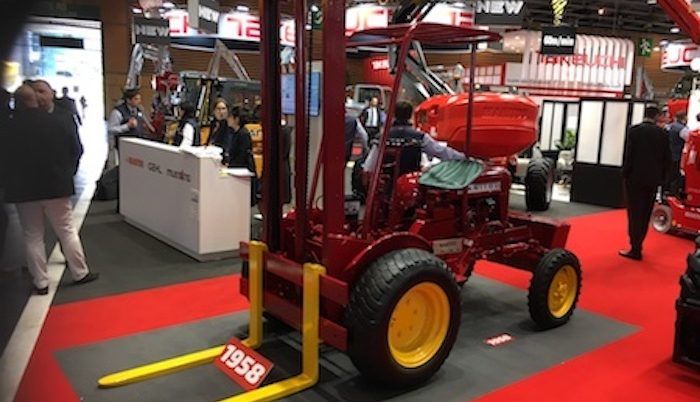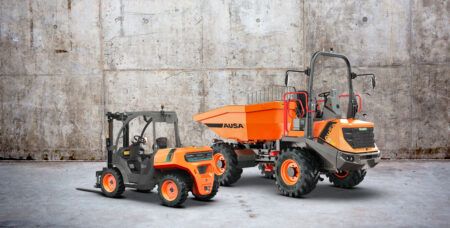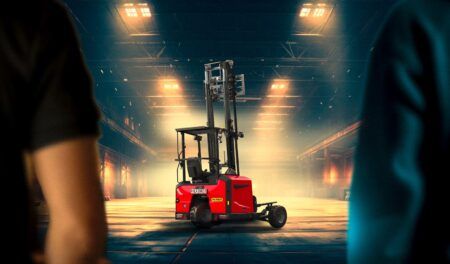Manitou marked its 60th anniversary at Intermat Paris this week (April 23-28) not only by holding a huge gathering of the company’s dealers from around the world, but also launching an extension to its MC compact rough terrain forklift line.
This year marks 60th anniversary since the launch of its first rough terrain masted forklift – a restored model of which was on the company’s Intermat stand (above).
Now its current 1.8t-capacity MC18 has been joined by two new models, the MC25 and MC35, with respective maximum lift capacities of 2.5t and 3.5t. Both lift to a maximum height of 5.5m.
Kubota provides the powerplants for both machines courtesy of a Stage IIIA three-cylinder unit that provides 36.5kW (47hp), driving through a hydrostatic transmission. The MC25 is 1.99m high, and Manitou says it sees a strong market for such model in agricultural operations where users demand a machine that can access low buildings but at the same time cope with tough terrain outside, and there are goods to be moved between the two. Options include two- or four-wheel drive and a safety frame or full cabin.
“While the market for rough terrain masted forklifts for use in most farming operations has shrunk as telescopic handlers have taken over, there is still a market in specialist farming operations,” Mark Ormond, recently appointed as managing director of Manitou’s UK business, tells iVT.
“Most modern farming operations are well-equipped with concrete yards, but in agriculture there’s always a necessity to also be able to handle rough terrain. That field to yard capability is what we’ve focused on here.”
The firm also took the opportunity to show off revisions to its line of aerial work platforms. In a move to reduce noise in urban areas, the 18m 180 ATJ on the Intermat stand features a Kubota three-cylinder engine that, at 38kW, has an output 7kW less than previously, but incorporates revised componentry claimed to mean this has negligible effect on performance and significant benefits for fuel consumption, aided by a new 30-second idle power-off feature.
“Public impact of operations is becoming an ever more important criteria in machine purchase decisions, hence our engineers’ focus on lowering noise levels,” says Ormond. “Alongside the desire to limit impact on both the environment and on owners’ profitability, this is what has driven the revisions to the machine.”
Also on show was Manitou’s Intermat medal-winning new stabiliser system for its 24m and 30m MRT rotary telescopic machines (above). This uses a strain gauge-type system to automatically adjust the machine’s load capabilities according to the extent of stabiliser extension.
Meanwhile, there was also some skid-steer news from the firm, with more prominent Manitou branding on Mustang machines for some markets, and a new tracked version of the 1,650kg/3.03m Gehl RT165 to joined the existing RT215, the other model in the range with a track option.
By Martin Rickatson





